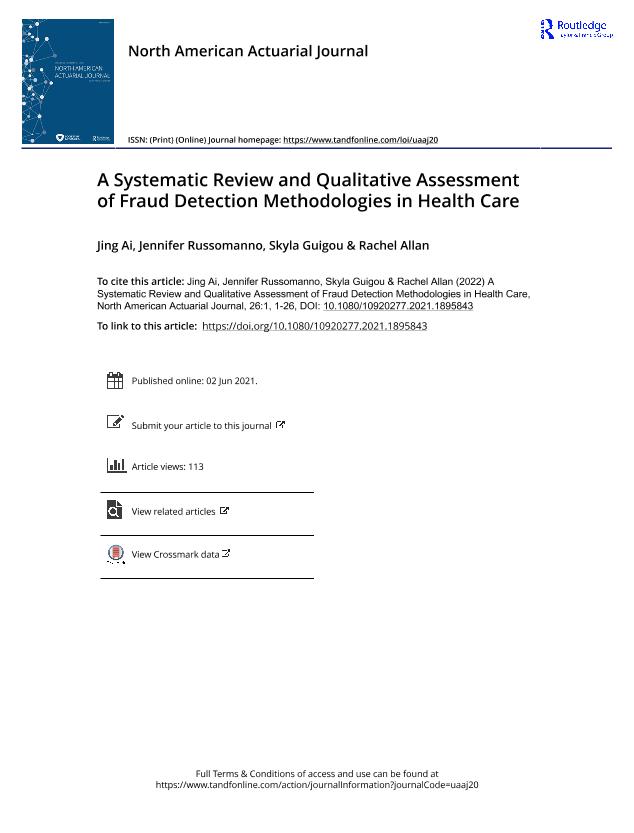A Systematic Review and Qualitative Assessment of Fraud Detection Methodologies in Health Care

Contenido multimedia no disponible por derechos de autor o por acceso restringido. Contacte con la institución para más información.
| Tag | 1 | 2 | Value |
|---|---|---|---|
| LDR | 00000cab a2200000 4500 | ||
| 001 | MAP20220008495 | ||
| 003 | MAP | ||
| 005 | 20220823212703.0 | ||
| 008 | 220315e20220307esp|||p |0|||b|spa d | ||
| 040 | $aMAP$bspa$dMAP | ||
| 084 | $a6 | ||
| 245 | 0 | 0 | $aA Systematic Review and Qualitative Assessment of Fraud Detection Methodologies in Health Care$cJing Ai...[et.al.] |
| 520 | $aHealth care fraud is a costly, challenging problem in health insurance. This study provides a systematic evaluation and synthesis of the methodologies and data samples used in current peer-reviewed studies from different academic fields on characterizing health care fraud. The Preferred Reporting Items for Systematic Reviews and Meta-Analyses (PRISMA) statement was used to guide reviewing the literature. In addition, a qualitative case study approach was employed to assess the studies included in the review in order to independently confirm the conclusions of the systematic review. Out of the 450 articles that were identified by the search criteria, 27 studies were deemed as relevant and included in the analysis. Using 24 variables designed from the literature to synthesize the fraud detection methodologies, the systematic review showed an inability to compare studies quantitatively because few studies reported the accuracy of their detection methods or the overall rate of fraud. The qualitative assessment independently confirmed that prior studies are highly diverse, with the only common characteristic being widespread use of data mining methods. Applying a previously validated approach that has not been taken by prior health care fraud reviews, our qualitative method showed high validity in terms of reviewers' agreement on the classification of fraud detection methods (r = 93%). Two limitations of this study are that the strength of the evidence is reliant on the quality and number of studies previously performed on the topic, and our systematic review and qualitative results were limited to the text of the final studies as published in peer-reviewed journals. The main gaps we identified are the need to validate existing methods, lack of proof of intent to commit fraud, absence of a fraud rate estimate in the studies analyzed, and inability to use prior evidence to select the best fraud detection method(s). Additional research designed to address these gaps would be of value to researchers, policymakers, and health care practitioners who aim to select the best fraud detection methods for their specific area of practice. | ||
| 650 | 4 | $0MAPA20080591052$aFraude en el seguro | |
| 650 | 4 | $0MAPA20080573867$aSeguro de salud | |
| 650 | 4 | $0MAPA20080575595$aDetección y alarma | |
| 650 | 4 | $0MAPA20080554323$aEvaluación | |
| 650 | $0MAPA20080541064$aFraude | ||
| 773 | 0 | $wMAP20077000239$g07/03/2022 Tomo 26 Número 1 - 2022 , p. 1-26$x1092-0277$tNorth American actuarial journal$dSchaumburg : Society of Actuaries, 1997- |

